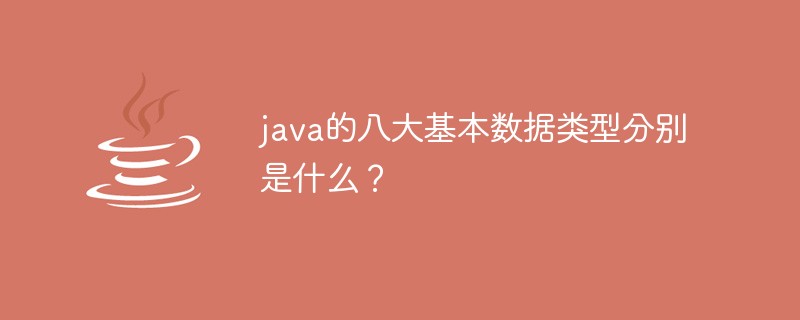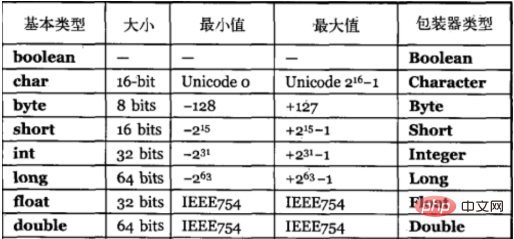The eight basic data types of Java are: 1. Integer type byte, short, int, long; 2. Character type char; 3. Floating point type float, double; 4. Boolean type boolean.

(Recommended tutorial: java introductory tutorial)
Since the release of Java, the basic data types have been in the Java language Part of them are byte, short, int, long, char, float, double, boolean.

1. Integer type
Integer data in Java are signed numbers, that is, the first bit is 0, which means a positive integer. A bit of 1 represents a negative integer. In computers, negative numbers are represented by complements, so how are complements calculated? (Recommended video tutorial:java video tutorial)
Complement code = negate the source code by 1;
For example: 22, represented in the computer as 00010110, -22, negated: 11101001, plus 1: 11101010
byte
byte is an integer type in Java. The length is 1 byte and 8 bits. The value is 10000000 (-128) to 01111111 (127). The default value of variable initialization is 0. Packaging Class Byteshort
#short is an integer type in Java, with a length of 2 bytes and 16 bits, and a value of 10000000 00000000 (-32768) To 01111111 11111111 (32767), the default value of variable initialization is 0, and the packaging class Shortint
int belongs to the integer type in Java, The length is 4 bytes and 32 bits, and the value is -2^31 (-2,147,483,648) to 2^31-1 (2,147,483,647). The default value of variable initialization is 0, packaging class Integerlong
long is an integer type in Java, with a length of 8 bytes and 64 bits, and a value of -2^63 (-9,223,372,036,854,775,808) to 2^63-1 (9,223,372,036,854,775,8087). The default value of variable initialization is 0 or 0L, and the packaging class Long2. Floating point type
Floating point data in Java cannot be converted into binary Direct representation, but an approximate data representation for real numbers, which follows the IEEE 754 standardfloat
float belongs to Java Floating point type, also called single-precision floating point type, length is 4 bytes and 32 bits, variable initialization default value is 0.0f, packaging class Float1. float structure
Contains three parts:Sign bit, exponent bit, mantissa bit
|
##Sign bit (S) |
Exponent bit (E) | Mantissa bit(M) | |||||||||||||
|---|---|---|---|---|---|---|---|---|---|---|---|---|---|---|---|
| 8bit | 23bit | Explanation | |||||||||||||
| The format is | , E Value range: (0,255), exponent value: ( | ,
  is in the form of 1.M or 0.M. Among them, when E=0, take 1.M, which is called the normal form. When E! = 0, take 0.M, which is called the informal form is in the form of 1.M or 0.M. Among them, when E=0, take 1.M, which is called the normal form. When E! = 0, take 0.M, which is called the informal form 
|
| Exponent bit (E) | Mantissa bit(M) | ||
|---|---|---|---|
| 1bit | 11bit | 52bit | |
| 0 represents a positive number, 1 represents a negative number | The format is | , E value range : (0,2047), the exponent bit value: (,  ) )  is in the form of 1.M or 0.M. Among them, when E=0, take 1.M, which is called the normal form. When E! = 0, take 0.M, which is called the informal form is in the form of 1.M or 0.M. Among them, when E=0, take 1.M, which is called the normal form. When E! = 0, take 0.M, which is called the informal form |
Formal form:
 Informal form:
Informal form:
 According to the above formula, it is easy to calculate the value range of double:
According to the above formula, it is easy to calculate the value range of double:
(minimum value, when the sign bit S is 1. The exponent bit E is 2047) 
(maximum value, when the sign bit S is 0, the exponent bit E is 2047) 
can get the approximate data in between.
## to express the amount. Three. Character type
char
Char is a character type in Java, occupies 2 bytes and 16 bits. It can assign single characters and integer values. There is no default value for variable initialization, and it is a packaging class Character.
For example: char a = 'a';char a = '中';char a = 12; // Value range 0~65536, because the char type has corresponding values ??in ASCII character encoding, and can be directly operated and output the corresponding characters in the character table 4. Boolean typeboolean
The JVM does not provide boolean-specific bytecode instructions, and boolean type data is passed through After compilation, it will be represented by the int type in the JVM. At this time, the boolean data is 4 bytes and 32 bits, and the boolean array will be encoded into a byte array of the Java virtual machine. At this time, each boolean data occupies 8 bits per byte.
--Java Virtual Machine SpecificationFor more programming-related knowledge, please visit:There are only two values ??true, false, and the default value of variable initialization is false
Programming Teaching
! !The above is the detailed content of What are the eight basic data types of Java?. For more information, please follow other related articles on the PHP Chinese website!

Hot AI Tools

Undress AI Tool
Undress images for free

Undresser.AI Undress
AI-powered app for creating realistic nude photos

AI Clothes Remover
Online AI tool for removing clothes from photos.

Clothoff.io
AI clothes remover

Video Face Swap
Swap faces in any video effortlessly with our completely free AI face swap tool!

Hot Article

Hot Tools

Notepad++7.3.1
Easy-to-use and free code editor

SublimeText3 Chinese version
Chinese version, very easy to use

Zend Studio 13.0.1
Powerful PHP integrated development environment

Dreamweaver CS6
Visual web development tools

SublimeText3 Mac version
God-level code editing software (SublimeText3)
 VSCode settings.json location
Aug 01, 2025 am 06:12 AM
VSCode settings.json location
Aug 01, 2025 am 06:12 AM
The settings.json file is located in the user-level or workspace-level path and is used to customize VSCode settings. 1. User-level path: Windows is C:\Users\\AppData\Roaming\Code\User\settings.json, macOS is /Users//Library/ApplicationSupport/Code/User/settings.json, Linux is /home//.config/Code/User/settings.json; 2. Workspace-level path: .vscode/settings in the project root directory
 How to handle transactions in Java with JDBC?
Aug 02, 2025 pm 12:29 PM
How to handle transactions in Java with JDBC?
Aug 02, 2025 pm 12:29 PM
To correctly handle JDBC transactions, you must first turn off the automatic commit mode, then perform multiple operations, and finally commit or rollback according to the results; 1. Call conn.setAutoCommit(false) to start the transaction; 2. Execute multiple SQL operations, such as INSERT and UPDATE; 3. Call conn.commit() if all operations are successful, and call conn.rollback() if an exception occurs to ensure data consistency; at the same time, try-with-resources should be used to manage resources, properly handle exceptions and close connections to avoid connection leakage; in addition, it is recommended to use connection pools and set save points to achieve partial rollback, and keep transactions as short as possible to improve performance.
 Mastering Dependency Injection in Java with Spring and Guice
Aug 01, 2025 am 05:53 AM
Mastering Dependency Injection in Java with Spring and Guice
Aug 01, 2025 am 05:53 AM
DependencyInjection(DI)isadesignpatternwhereobjectsreceivedependenciesexternally,promotingloosecouplingandeasiertestingthroughconstructor,setter,orfieldinjection.2.SpringFrameworkusesannotationslike@Component,@Service,and@AutowiredwithJava-basedconfi
 python itertools combinations example
Jul 31, 2025 am 09:53 AM
python itertools combinations example
Jul 31, 2025 am 09:53 AM
itertools.combinations is used to generate all non-repetitive combinations (order irrelevant) that selects a specified number of elements from the iterable object. Its usage includes: 1. Select 2 element combinations from the list, such as ('A','B'), ('A','C'), etc., to avoid repeated order; 2. Take 3 character combinations of strings, such as "abc" and "abd", which are suitable for subsequence generation; 3. Find the combinations where the sum of two numbers is equal to the target value, such as 1 5=6, simplify the double loop logic; the difference between combinations and arrangement lies in whether the order is important, combinations regard AB and BA as the same, while permutations are regarded as different;
 python pytest fixture example
Jul 31, 2025 am 09:35 AM
python pytest fixture example
Jul 31, 2025 am 09:35 AM
fixture is a function used to provide preset environment or data for tests. 1. Use the @pytest.fixture decorator to define fixture; 2. Inject fixture in parameter form in the test function; 3. Execute setup before yield, and then teardown; 4. Control scope through scope parameters, such as function, module, etc.; 5. Place the shared fixture in conftest.py to achieve cross-file sharing, thereby improving the maintainability and reusability of tests.
 Understanding the Java Virtual Machine (JVM) Internals
Aug 01, 2025 am 06:31 AM
Understanding the Java Virtual Machine (JVM) Internals
Aug 01, 2025 am 06:31 AM
TheJVMenablesJava’s"writeonce,runanywhere"capabilitybyexecutingbytecodethroughfourmaincomponents:1.TheClassLoaderSubsystemloads,links,andinitializes.classfilesusingbootstrap,extension,andapplicationclassloaders,ensuringsecureandlazyclassloa
 How to work with Calendar in Java?
Aug 02, 2025 am 02:38 AM
How to work with Calendar in Java?
Aug 02, 2025 am 02:38 AM
Use classes in the java.time package to replace the old Date and Calendar classes; 2. Get the current date and time through LocalDate, LocalDateTime and LocalTime; 3. Create a specific date and time using the of() method; 4. Use the plus/minus method to immutably increase and decrease the time; 5. Use ZonedDateTime and ZoneId to process the time zone; 6. Format and parse date strings through DateTimeFormatter; 7. Use Instant to be compatible with the old date types when necessary; date processing in modern Java should give priority to using java.timeAPI, which provides clear, immutable and linear
 Google Chrome cannot open local files
Aug 01, 2025 am 05:24 AM
Google Chrome cannot open local files
Aug 01, 2025 am 05:24 AM
ChromecanopenlocalfileslikeHTMLandPDFsbyusing"Openfile"ordraggingthemintothebrowser;ensuretheaddressstartswithfile:///;2.SecurityrestrictionsblockAJAX,localStorage,andcross-folderaccessonfile://;usealocalserverlikepython-mhttp.server8000tor










